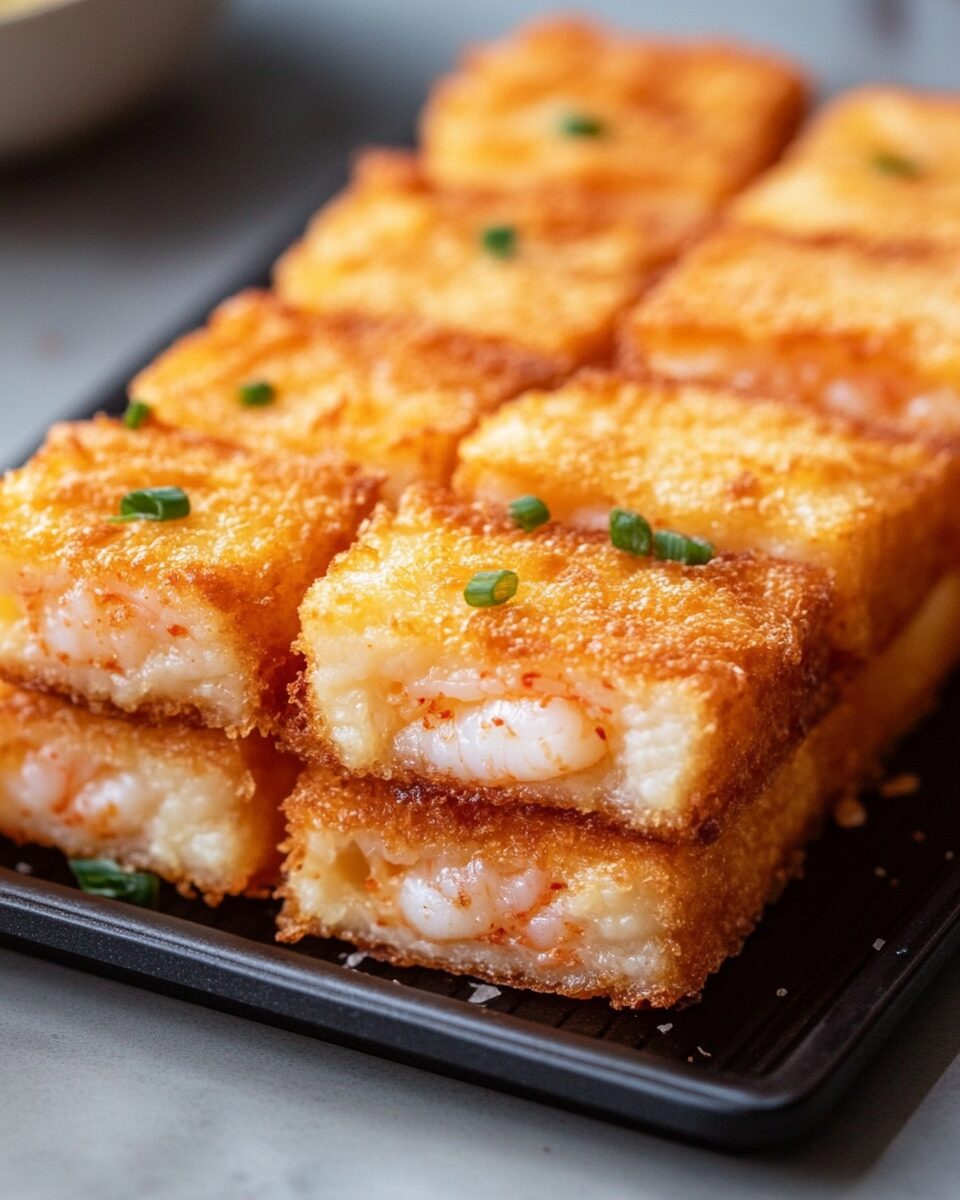A Korean-Chinese fusion dish, Menbosha features crispy, golden-brown bread pockets filled with a savory shrimp paste. These bite-sized treats are delightfully crunchy on the outside and tender on the inside, making them a perfect appetizer or snack for any occasion.
FULL RECIPE
Ingredients
- 12 slices white sandwich bread (crusts removed)
- 10 oz (approx. 280g) raw shrimp (peeled and deveined)
- 1 egg white
- 1 garlic clove (minced)
- 1 tsp ginger (minced)
- 1 tsp sesame oil
- 1 tsp soy sauce
- 1/2 tsp sugar
- 1/4 tsp salt
- 1/8 tsp ground white pepper
- 2 Tbsp potato starch or cornstarch
- Vegetable oil (for deep frying)
Directions
- Chop the shrimp into a paste using a knife or food processor until smooth.
- In a bowl, combine shrimp paste, egg white, garlic, ginger, sesame oil, soy sauce, sugar, salt, white pepper, and starch. Mix well until sticky and fully blended.
- Take one slice of crustless bread and place a spoonful of shrimp paste in the center. Top with another slice and press gently to form a sandwich.
- Lightly press the edges to seal. Trim into smaller squares or rectangles as desired.
- Heat oil in a deep pan to 340–350°F (170–180°C).
- Carefully add the shrimp toast pieces to the oil and fry until golden and crispy, about 2–3 minutes per side.
- Remove and drain on paper towels. Serve hot with dipping sauce if desired.
Nutritional Information
- Calories: 160–180 per piece
- Protein: 9g
- Fat: 8g
- Carbohydrates: 12g
- Sodium: 350mg
- Cholesterol: 60mg
History of Menbosha
Menbosha, also known as fried shrimp toast, is a beloved dish in Korean-Chinese cuisine. Its origins trace back to Chinese immigrants in Korea who adapted traditional Chinese recipes to the local tastes and ingredients. This dish is popular in Korean-Chinese restaurants, especially as an appetizer or snack. The combination of crispy bread and savory shrimp filling makes it a satisfying bite-sized treat. While the dish has Chinese roots, it has become uniquely Korean in its preparation, often served with a side of sweet and sour dipping sauce.
The Fusion of Korean and Chinese Flavors
The fusion of Korean and Chinese flavors in Menbosha is what sets it apart from traditional Chinese shrimp toast. While the concept of shrimp toast originated in China, Menbosha incorporates Korean seasonings like sesame oil and soy sauce. This combination of flavors creates a distinctive taste that appeals to the Korean palate, where savory, umami-packed ingredients are highly valued.
The Role of Shrimp in Menbosha
Shrimp is the star ingredient in Menbosha, providing both a sweet and savory flavor profile that complements the crunch of the fried bread. The shrimp paste used in the filling is blended until smooth, which results in a delicate texture that contrasts with the crispy toast. Shrimp is also a healthy protein choice, rich in omega-3 fatty acids and other essential nutrients.
Crispy Perfection: The Secret to the Crunch
The key to a perfect Menbosha lies in achieving the right level of crispiness. The bread used should be fresh and soft on the inside, while the exterior must be golden and crunchy. The frying technique plays a crucial role in this. Deep frying the Menbosha at the right temperature ensures that the bread does not absorb too much oil and becomes overly greasy. Achieving this balance of crispy texture and tender shrimp filling is essential for a satisfying dish.
The Use of Potato Starch
Potato starch is a common ingredient in Menbosha, used to bind the shrimp paste and create a smooth consistency. It also helps in achieving the crispy coating when frying. Potato starch is preferred over cornstarch in some recipes because it results in a lighter, airier texture when fried. The starch acts as a binder, ensuring that the shrimp paste stays together inside the bread without spilling out.
The Importance of Fresh Bread
For Menbosha, it is crucial to use fresh white bread. The bread should be soft and free from the crust, as the crust can become too tough when fried. The softness of the bread ensures that it absorbs the flavors of the shrimp paste and becomes tender when deep fried. It is also easier to seal the bread edges without the crust, creating a perfect pocket for the shrimp filling.
Menbosha as an Appetizer
In Korean-Chinese restaurants, Menbosha is typically served as an appetizer. Its small size makes it perfect for sharing, and the crispy texture paired with the savory shrimp filling is always a crowd-pleaser. It is often enjoyed with a dipping sauce on the side, such as sweet and sour sauce or a soy-based dipping sauce, which adds an extra layer of flavor.
Menbosha and Its Variations
While the traditional Menbosha recipe uses shrimp as the main filling, there are many variations that can be made. Some recipes use a combination of shrimp and other seafood, like crab or squid. Others may include additional ingredients such as chopped vegetables or cheese to enhance the flavor. These variations allow for creativity in the kitchen, making Menbosha a versatile dish.
Serving Menbosha with Dipping Sauces
Dipping sauces are an essential part of Menbosha. The right sauce can elevate the dish by adding tanginess, sweetness, or spiciness. Popular dipping sauces for Menbosha include sweet and sour sauce, soy sauce with a touch of vinegar, and spicy mustard. The balance of flavors in the sauce complements the richness of the fried shrimp toast, creating a well-rounded eating experience.
Menbosha as a Snack or Party Food
Menbosha makes for an excellent snack or party food. Its small, bite-sized portions are easy to serve at gatherings, and its crunchy texture and savory filling are sure to satisfy guests. Whether served as a starter at a dinner party or as part of a larger spread of appetizers, Menbosha is a guaranteed hit.
Health Benefits of Shrimp
Shrimp is a nutritious seafood option that provides various health benefits. It is low in calories and high in protein, making it a great choice for those looking to maintain a healthy diet. Shrimp is also rich in antioxidants, such as astaxanthin, which help protect the body from oxidative stress. In addition, shrimp contains essential vitamins and minerals, including vitamin B12, iodine, and selenium.
The Popularity of Korean-Chinese Cuisine
Korean-Chinese cuisine, or “Chungmu,” has gained widespread popularity in recent years. This fusion cuisine blends traditional Chinese dishes with Korean ingredients and techniques. Menbosha is just one example of how Korean-Chinese food has evolved to suit local tastes. The popularity of dishes like Menbosha highlights the growing demand for unique, flavorful foods that offer a mix of cultures and culinary traditions.
The Influence of Korean Cuisine on Global Food Trends
Korean cuisine has been making waves on the global food scene in recent years. With the rise of K-pop and Korean dramas, there has been a surge in interest in Korean food. Menbosha, as part of the Korean-Chinese culinary tradition, has benefited from this trend. The fusion of Chinese and Korean flavors has resonated with food lovers worldwide, leading to an increased demand for dishes like Menbosha in international markets.
Perfect Pairings with Menbosha
Menbosha pairs well with a variety of side dishes and beverages. It is often served alongside kimchi, pickled vegetables, or a light salad to balance out the richness of the fried shrimp toast. For beverages, Menbosha goes well with light, crisp drinks like iced tea, beer, or even a refreshing glass of soju. The key is to pair it with something that complements the dish’s savory and slightly sweet flavors.
Cultural Significance of Menbosha in Korea
In Korea, Menbosha is more than just a popular food item; it holds cultural significance. It is often associated with the comfort of home-cooked meals or casual dining experiences. Menbosha is also commonly enjoyed during family gatherings, where sharing food is a symbol of togetherness and bonding. Its widespread popularity in Korean-Chinese restaurants also reflects the integration of Chinese immigrants and their influence on Korean food culture.
Why Menbosha is So Addictive
The addictive nature of Menbosha can be attributed to the combination of textures and flavors. The crispy, golden exterior contrasts beautifully with the soft, flavorful shrimp filling. The savory umami of the shrimp, combined with the subtle sweetness from the bread, creates a satisfying bite. When paired with a tangy dipping sauce, the dish becomes even more irresistible. It’s this perfect balance of flavors and textures that keeps people coming back for more.
The Versatility of Menbosha
One of the reasons Menbosha has become so popular is its versatility. It can be made with different proteins or even vegetables, making it suitable for a variety of dietary preferences. Whether you are a seafood lover or a vegetarian, there are ways to adapt the recipe to suit your taste. This adaptability makes Menbosha a great dish for both home cooks and professional chefs alike.
Tips for Making Menbosha at Home
Making Menbosha at home can be a fun and rewarding experience. To ensure the best results, it’s important to use fresh bread and high-quality shrimp. The shrimp paste should be smooth and well-seasoned to achieve the best flavor. Additionally, be sure to fry the Menbosha at the right temperature to achieve the perfect crispiness without overcooking the filling. A deep fryer or a thermometer can help maintain the ideal frying temperature.
Storing Leftover Menbosha
If you have leftovers, it’s best to store them in an airtight container in the refrigerator. However, because Menbosha is fried, the bread may lose its crispiness over time. To revive the texture, you can reheat the Menbosha in an oven or toaster oven to bring back some of the crunch. While it’s always best to enjoy Menbosha fresh, reheating it properly can help preserve its flavor.
Conclusion
Menbosha is a delicious and versatile dish that combines the best of Korean and Chinese culinary traditions. With its crispy exterior and savory shrimp filling, it’s a dish that offers a satisfying blend of textures and flavors. Whether served as an appetizer, snack, or part of a larger meal, Menbosha is sure to impress. With a rich history, cultural significance, and endless variations, Menbosha continues to be a favorite among food lovers.






